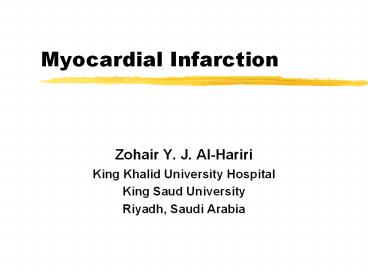Myocardial Infarction PowerPoint PPT Presentation
1 / 11
Title: Myocardial Infarction
1
Myocardial Infarction
- Zohair Y. J. Al-Hariri
- King Khalid University Hospital
- King Saud University
- Riyadh, Saudi Arabia
2
What is MI?
- Myocardial infarction is the death of part of the
heart muscle due to its sudden loss of blood
supply. - Death of the heart muscle often causes chest pain
and electrical instability of the heart muscle
tissue. - Approximately one million Americans suffer a
heart attack annually. - Approximately 90 to 95 of heart attack victims
who reach the hospital survive.
3
What causes MI?
- A MI is caused by the formation of a blood clot
on a cholesterol plaque. - Cholesterol plaque is the formation of a hard,
thick substance within the artery walls which is
caused by deposits of cholesterol in the artery
walls - During exercise or excitement, the narrowed
coronary arteries cannot increase the blood
supply to meet the increased oxygen demand of the
heart muscle. - Occasionally the surface of the cholesterol
plaque in the artery may rupture, then completely
occludes blood flow in the vessel and results in
a heart attack.
4
What causes MI?(cont.)
- Irreversible risk factors
- Age
- Gender
- Family history
- Potentially reversible risk factors
- Hyperlipidaemia
- Smoking
- Hypertension
- Other factors
5
What are the symptoms of MI?
- Chest pain or pressure is a common symptom of MI.
- Cardiac chest pain is often vague.
- MI frequently occur from 400 A.M. to 1000 A.M.
- Interestingly, MI do not usually happen during
exercise. - Approximately one quarter of all heart attacks
are silent, without chest pain. - Heart attack victims may complain of
- chest pressure
- sweating
- jaw pain
- heartburn and/or indigestion
- SOB
- arm pain (more commonly the left arm, but may be
either) - upper back pain
- general malaise (vague feeling of illness)
- nausea
6
How is a MI diagnosed?
- The initial diagnosis of MI is made by a
combination of clinical symptoms and
characteristic ECG changes. - Confirmation of MI can only be made hours later
through detection of elevated cardiac enzymes. - Other investigations.
- Rapid evaluation allows early treatment of
potentially life-threatening arrhythmias, and
permits early reperfusion. - NB Achieving PROMPT MEDICAL ATTENTION is the THE
MOST IMPORTANT FACTOR for an improved prognosis
with a heart attack.
7
What are the treatment options for an MI?
- Recanalisation.
- Optimal benefit is obtained if reperfusion can be
established in the first 4- 6 hours of the
attack. - Cardiac catheterization facility (PTCA).
- The angiogram allows evaluation of the status of
the other coronary arteries. - Stenting.
- Addition of newer super aspirins
8
What are the treatment options for an MI? (cont.)
- Thrombolytic agents.
- Anti-platelet agents.
- Heparin.
- Nitroglycerin.
- ACE inhibitors.
- Beta blocking agents.
- coronary artery bypass graft (CABG) surgery.
9
How does a patient recover from MI?
- MI patients are monitored in the hospital for 3
or more days prior to discharge home. - Arrythmias, shortness of breath due to heart
failure, or recurrent pain are indications for
further therapy. - Patients gradually increase their activity under
observation. - After a small heart attack, patients can usually
resume normal activities after two weeks. - A moderate heart attack requires limited,
gradually increasing activity for up to four
weeks. A - Large heart attack may result in a recovery
period of six weeks or longer.
10
How to prevent MI recurrence?
- Aspirin and beta blockers.
- Stopping smoking, reducing weight and dietary
fat, controlling blood pressure and diabetes,
along with regular, carefully prescribed
exercise. - Reduction of LDL cholesterol to a value below 100
mg/dl has been particularly demonstrated to have
a beneficial effect on long-term prognosis. - ACE inhibitors.
- Further cardiac stress testing.
11
What is in the future of MI patient?
- Greater public awareness and lifestyle changes.
- Hirudin and Hirulog, are being tested to
complement current therapies. - The role of the super aspirins (Reopro,
Integrellin, and Aggrastat) is currently being
investigated as well. - Newer versions of t-PA are being developed.
- With the widespread application of modern
in-hospital and out of hospital programs for
heart attack patients, the long-term prognosis
following a heart attack will only improve.

